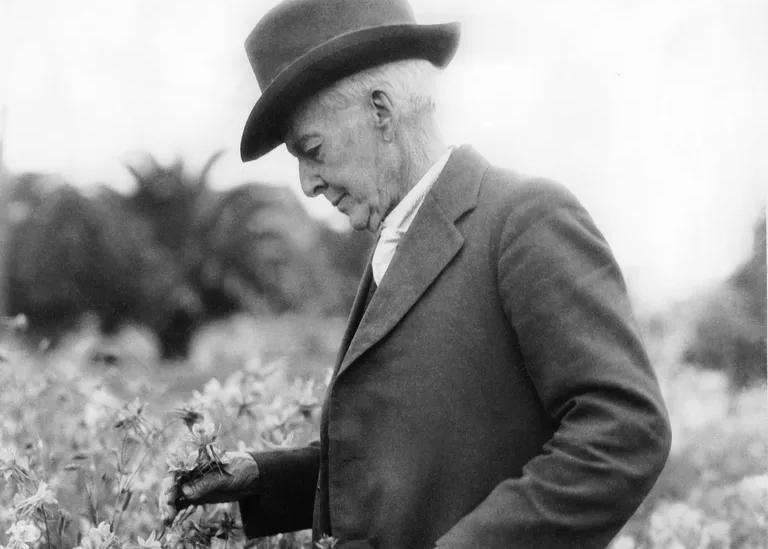In a world of large-scale agriculture, it’s sometimes easy to forget about the human effort that goes into cultivating a particular breed of plant. But if you’ve ever bitten into a McDonald’s French fry or enjoyed the snow-white blossoms of a Shasta daisy, you already know something of the American horticulturist Luther Burbank. Burbank, who was born in Lancaster, Massachusetts in 1849, is regarded as an agricultural pioneer — he developed some 800 strains and varieties of plants in his lifetime. And while Burbank’s association with the eugenics movement has tainted his reputation in the decades since his death, his contributions to botany resulted in many of the popular flowers, fruits, and tubers that Americans know and love today.*
Burbank’s affinity for plants began when he was just a boy, exploring his mother’s Lancaster gardens. When Burbank’s father passed away, the 18-year-old garden enthusiast used his inheritance to purchase a 17-acre farm near the center of Lunenburg. Burbank found inspiration in Charles Darwin’s The Variation of Animals and Plants under Domestication, and began experimenting with varieties of potatoes that could withstand blight like the one that had decimated crops in Ireland in the mid-1800s. He sold the rights to one of his creations — the Burbank potato — for $150. Due to its hardy composition, a later version of the Russet Burbank potato would become the most widely cultivated potato in the United States, and the core ingredient in McDonald’s French fries.
Burbank used his earnings from the sale of the Burbank potato to relocate to Santa Rosa, California. There, he began a small seed and nursery business to help finance his botanical experiments. Burbank’s seed catalogs grew in popularity and began attracting the attention of investors like Clarence McDowell Stark and Andrew Carnegie. This additional funding allowed Burbank to focus on his hybridization efforts — crossbreeding apples, plums, berries, and other fruits.
But in spite of his hundreds of contributions to the world of edible fruits, Burbank’s most lasting legacy is that of the Shasta Daisy. Burbank’s experiments with the daisy first began in 1884 and lasted some 17 years. The plants are a quadruple hybrid, an amalgam of four varieties including oxeye daisies from Burbank’s home in New England. Burbank engineered the plant to produce large, pure white blooms, and sturdy, smooth stems that could withstand both outdoor garden environments and ornamental cuttings. The flowers, named after the white snows of Mt. Shasta and introduced in 1901, are still a favorite among modern gardeners.
Perhaps unsurprisingly, Burbank’s interest in genetics extended to human heredity. He was elected to the American Breeders’ Association Committee on Eugenics in 1906 and wrote frequently for the association’s publications. Burbank’s 1907 book The Training Of The Human Plant made an argument for a “wisely directed” crossing of the human species through “rigid selection.”
These views have rightfully earned Burbank criticism in the modern age, but the chief critique from Burbank’s contemporaries was the botanist’s lack of scientific record-keeping. It’s true that Burbank’s experiments were not always scientifically rigorous, but the results of his hybridizations were widely and frequently applauded.
After Burbank’s death in 1926, his work spurred the passing of the 1930 Plant Patent Act, which allowed botanists to patent new varieties of plants. His home and gardens in Santa Rosa became a National Historic Landmark, and his experimental farm is listed on the National Register of Historic Places. Institutions and schools across the country — including the Luther Burbank Middle School in Lancaster, Massachusetts — bear Burbank’s name in celebration of the horticulturalist’s myriad contributions to the world of plants.
Sources: lutherburbank.org
Photo courtesy of Getty Images
* A note on eugenics: First coined during the late nineteenth century, eugenics is the science and practice of improving the quality of the human race through controlled reproduction. Eugenicists promoted different measures to control who could reproduce: segregation of the unfit in asylums and other institutions, laws requiring marriage certificates proving health, and the sterilization of disabled people.
In The Training of the Human Plant (1907), Burbank described a system of eugenics that would treat humans in the same manner as a horticulturist treated plants. Just as the bad qualities of plants can be bred out through crossbreeding, so too could “unfit” qualities in humans be eradicated through eugenics.
Freedom’s Way National Heritage Area acknowledges that the thoughts and actions of those whose stories we share may be morally flawed and problematic in modern times. In our role as storyteller, Freedom’s Way works to ensure that the complex histories we explore are presented in their entirety and condemns any theories or practices that deny others their right to life, liberty, and the pursuit of happiness.

